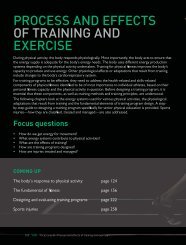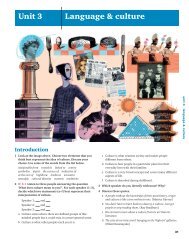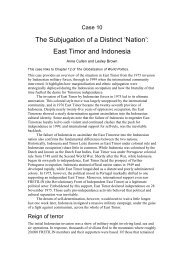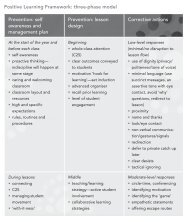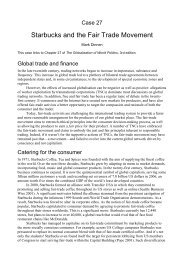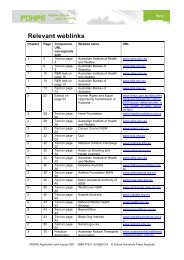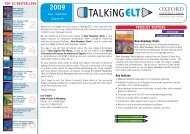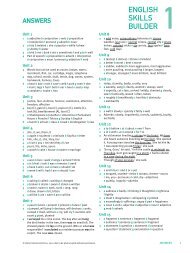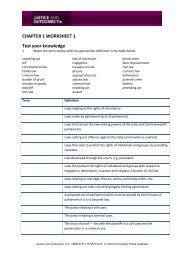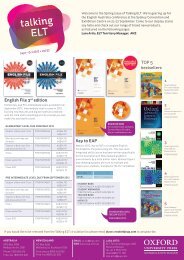2 Chapter 6 ⢠organising elements Organising elements
2 Chapter 6 ⢠organising elements Organising elements
2 Chapter 6 ⢠organising elements Organising elements
You also want an ePaper? Increase the reach of your titles
YUMPU automatically turns print PDFs into web optimized ePapers that Google loves.
Properties and structure<br />
6.2<br />
How do we organise <strong>elements</strong>?<br />
Remember and understand<br />
1 What is the name given to the following<br />
features of the periodic table?<br />
a a horizontal row<br />
b a vertical column<br />
c the set of ten groups from group 3 to<br />
group 12<br />
2 State the group number of the following sets<br />
of <strong>elements</strong>:<br />
a alkaline earth <strong>elements</strong><br />
b halogens<br />
c noble gases<br />
d alkali metals<br />
3 What is a valence shell?<br />
4 State the features that <strong>elements</strong> in the same<br />
group have in common.<br />
5 State the features that <strong>elements</strong> in the same<br />
period have in common.<br />
6 Suggest why transition metals are much more<br />
widely used than the alkali metals.<br />
7 Give explanations for the following.<br />
a Hydrogen was placed in the same group as a<br />
set of metals, even though it is a non-metal.<br />
b Helium was placed in the same group as<br />
the noble gases, even though its uncharged<br />
atoms have a different number of electrons<br />
in the valence shell to those of the other<br />
group members.<br />
8 An inert substance is one that will not react<br />
with any other substance. Originally, group<br />
18 <strong>elements</strong> were known as the ‘inert gases’.<br />
Suggest why the name was changed to<br />
‘noble gases’.<br />
<br />
Apply<br />
9 Only two <strong>elements</strong> are liquids at room<br />
temperature—bromine and mercury. Bromine is<br />
a non-metal and mercury is a metal. Describe<br />
how these two liquids are likely to appear and<br />
behave differently from each other.<br />
Analyse and evaluate<br />
10 a some sodium metal was introduced into a<br />
sealed jar containing chlorine gas. The metal<br />
and gas reacted to produce sodium chloride,<br />
which is table salt. Would you expect this<br />
reaction to need heat to get it going or would<br />
you expect it to produce heat? Would you<br />
expect it to be a mild reaction or a more violent<br />
one? Justify your answers.<br />
Properties and structure<br />
b What two <strong>elements</strong> would you expect to<br />
react together in the most violent way?<br />
Justify your answer.<br />
11 Before the 1980s, the groups of the periodic<br />
table were numbered with Roman numerals.<br />
Some scientists prefer this version because<br />
the uncharged atoms of the <strong>elements</strong> in<br />
group III (now 13) have three electrons in<br />
their valence shell, those in group IV (now 14)<br />
have four electrons in their valence shell and<br />
so on. Examine how the groups of transition<br />
metals were numbered in the old way. Which<br />
numbering system do you think is the most<br />
helpful? How can you deduce the number of<br />
electrons in the valence shell from the new<br />
group number?<br />
12 The <strong>elements</strong> are ordered according to their atomic number. Groupings reflect the properties of the <strong>elements</strong>.<br />
Properties can change when <strong>elements</strong> combine. How might the location of an element on the periodic table<br />
give you an indication of the likely combinations of <strong>elements</strong> and the potential property changes?<br />
UNCORRECTED PAGE PROOFS<br />
<strong>Chapter</strong> 6 • <strong>organising</strong> <strong>elements</strong><br />
17<br />
CAS_SB10_TXT_06_1pp.indd 17<br />
11/11/11 4:58 PM



